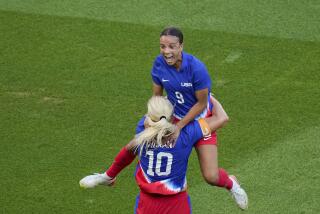A LOOK AT THE OTHER SPORTS...
- Share via
Tracie Ruiz has been serving an internship at a Seattle television station. Candy Costie has been playing in celebrity tennis tournaments and trying to market a family-recipe bread.
Both retired last summer after Ruiz, considered the best ever in her sport, won an Olympic gold medal in the synchronized swimming solo competition and combined with Costie to take the duet gold.
They still give exhibitions to promote their sport, but they didn’t necessarily take the United States’ dominance in synchronized swimming with them when they retired from competition.
In fact, the U.S. entries in the 1988 Olympics--whoever they are--could very well go in favored. The Canadians have a traditionally strong national program and should again give the U.S. a run for the gold. Canadians Sharon Hambrook and Kelly Kryczka took the duet silver last summer and Canadian Carolyn Waldo won a silver in the solo event.
The best in the U.S. at the moment are twins Karen and Sarah Josephson. Sarah, the Olympic alternate last year, won the solo competition at the recent U.S. Synchronized Swimming Championships in Ft. Lauderdale (June 30-July 7) and combined with her sister to win the duet title. But Karen has beaten Sarah in two other solo events this year.
The Josephsons, seniors at Ohio State this year, are committed to competing in the 1986 World Championships, but they have not decided about the possibility of hanging in there until 1988.
The next most recognizable names in U.S. synchronized swimming belong to another set of twins, Alice and Margarita Smith of Arizona State. They haven’t made their minds up about 1988, either.
Then there is the duet team of Kristen Babb, 16, and Michelle Svitenko, 19, who upset the Smiths to take second in U.S. Championships. And Mary Visniski, another member of synchronized swimming’s old guard, is still going strong. She finished just 1.3 points behind winner Sarah Josephson in the solo competition in Florida.
Of course, there is the strong possibility that none of these swimmers will still be competing in 1988.
“Most of our swimmers’ goals at this point are for the World Championships,” said Paula Oyer, U.S. Synchronized Swimming’s executive director. “We’re turning inward after the ’84 Games, spending a lot of time and money on developmental programs.”
Charlotte Davis, Ruiz’s and Costie’s coach, has been named the sport’s first national team coach, a move Oyer believes is a giant step toward improving the sport in this country. Davis will work with the club coaches to “create consistency throughout our programs and translate from the elite levels to the developmental levels,” according to Oyer.
“It’s a bit premature to look at the 1988 Olympic solo and duet events at this point,” Oyer said, “but we recently sent an age-group team to Spain comprised entirely of 13-and 14-year-olds. They came in second to the Canadian team that was made up of mostly 18-year-olds and beat all the European teams. I think we sent the rest of the world a message that we’re not coasting.”
The synchronized swimming world is hoping to get word that the team event will be added to the ’88 Games, and Oyer thinks the chances look pretty good at this point.
The addition of synchronized swimming in the 1984 Olympics was a new beginning for a sport that existed in almost total obscurity since the days of Esther Williams. A lot of little girls across the country fell in love with sequined swimsuits and slicked-down hairdos.
“The sport has really skyrocketed because of the Olympic games, both in interest and financially,” Oyer said. “We’ve got national sponsorship (McDonald’s) now and we’re investing in the long-term, doing what it takes to groom the up-and-comers, the people who will be there in ’88.”
More to Read
Go beyond the scoreboard
Get the latest on L.A.'s teams in the daily Sports Report newsletter.
You may occasionally receive promotional content from the Los Angeles Times.






